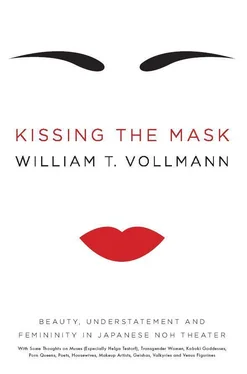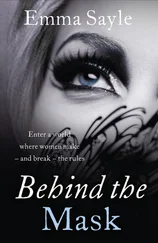4I have read, but do not believe, that “the transsexual’s position consists of wanting to be All, all woman, more woman than all women, and representing them all.” Transgender women each have their own look. In any event, it is interesting that both Catherine Millot, the psychoanalyst who wrote the quoted words, and Mr. Kanze insist that femininity’s general representaion is impossible or fallacious. Based on how I experience prehistoric Venus figurines (see below, p. 260), I cautiously assert that a general beauty can indeed be expressed.
5Small eyes remain emblematically Japanese outside Japan. (Many Vietnamese women also like them; sometimes they submit to operations to narrow their eyes.) In Nan Ning, China, a woman told me: “Chinese girl beauty is large eye. Japanese girl beauty is in narrow eye.” Then she added: “Japanese ochobo-guchi woman is obey husband. Chinese woman, in old society they have something the same as Japanese woman, but now more independent.”
1I am informed that “the crease lines between the eyebrows on statues of male Shinto gods and the dimples on the cheeks of young male and female Shinto statues appear to have been incorporated into Noh masks…”
2One study of the effect of mask angle upon perceptions of its expressed emotion found that a certain magojiro ’s mouth was much deeper than a human’s. This helped to facilitate the illusion. In laser scans of the masks at three different inclinations, we seem to see the top of the upper lip as a frown, a neutral horizontal which resembles the stylization of stretched bird’s wings, and a smile.
3This is what I heard over and over, especially from Noh actors and geishas. First, in the years of apprenticeship, the expression of beauty consists of exercises done by rote; then it happens, as Zeami implies, beyond consciousness. Of all the inhabitants I met in this subculture, Mr. Umewaka was the only one who articulated for me in detail what conscious choices he made. When I watch a woman making up her face, her self-description resembles that of the geishas. She rarely says: “I chose today to apply foundation in this way because …”
1In her early eleventh-century list of things that are near though distant, Sei Shonagon included “relations between a man and a woman.”
2Obviously the content of femininity varies over time and space. For instance, a certain young boy in Berlin feels drawn not only to wearing women’s clothes, but also to dusting. His great-uncle lovingly remarks that he should have been a girl in 1900; then he would have been “a pearl of a servant.” How many women do I know who actually enjoy dusting? The boy, who becomes Charlotte, describes herself throughout her life as a Hausfrau .
1For her part, Sordamour sewed one of her hairs beside a golden thread in the white silk shirt she gave to her sweetheart, because (says the poet) she wished to know whether a man might see any difference between the two.
2The transsexual Jennifer Finney Boylan states that her boyhood certainty of being in the wrong body “had nothing to do with a desire to be feminine , but it had everything to do with being female .” When I first began writing this book, I attempted to distinguish between these two terms, but found that each means so many different things to different people that insisting that one was this and the other was that came to seem like an insult.
3To which this book gives short shrift. The most plausible parsing that I have found of gender identity appears in an essay by the trans woman Julia Serano, who delineates (a) one’s “subconscious sex,” in other words one’s desire to be, for instance, female; (b) one’s “conscious sex” (being male-bodied and raised as a boy, she initially identified as male); (c) the gender to which one is attracted; and (d) the gender which other people tend to project upon a person. I feel ambivalent about the final quantity’s passive construction. The femininity of a great Noh actor is a triumph of active projection; and I would like to believe that every one of us can at least hope to control how he or she is seen. But it is certainly and sometimes sadly true that who we think we are may be irrelevant in the eyes of others. Some performances fail; others simply come to an end. I imagine a Jew who passes brilliantly as an Aryan, until a document reveals him to the Gestapo. Clearly a performance may be dangerous, exhausting or demeaning to the performer. In any event, Kissing the Mask deals less with any of Serano’s four categories than a “full treatment” would call for. My focus, being less moral than aesthetic, is limited to the strategies and effects of great performances. Serano for her part remarks: “When I eventually did transition” from male to female, “I chose not to put on a performance — I simply acted, spoke and dresed the way I always had…”
4As Lichtenberg wrote in his notebooks, ca. 1798: “Even the gentlest, most modest and best of girls are always better, gentler and more modest if their mirrors have told them that they are looking more beautiful than ever.”
5In his twentieth-century version of this same play, Mishima has Komachi say, no doubt with nasty irony: “I suppose a fool like you thinks every beautiful woman gets ugly as soon as she grows old… That’s a great mistake. A beautiful woman is always a beautiful woman. If I look ugly now, all it means is that I am an ugly beauty.”
6She added: “In Noh the male actor does not sound like a female, unlike in Kabuki. When we play a woman, we use our natural voice. In my opinion, we use our own body as a resonator. Try to make the best sound according to your own body. In other words, don’t imitate the male voice.”
7Here it is worth quoting the very convincing-sounding woman of the digital video disk called “Finding Your Female Voice.” “After you’ve hit puberty…” she says sadly, “that’s when your vocal cords thicken, and it’s irreversible.”
8In this play’s source, the Tales of Ise , there is an episode (Dan XXIII, p. 64) in which two children of the opposite sex grow up together, marry, have troubles and get reconciled, all after having played together at the well.
9This “yet” betrays my parochialism, for Aphrodite statuettes frequently identify themselves by means of their rolls of neck-flesh, which are accordingly known as “Venus rings.”
10An essay on Greek hetairai calls them “‘superfeminine’… supersoft, structurally most opposed to the masculine of hard Ares/Mars.”
11At the beginning of the fourteenth century, Lady Nijo expresses the idea that specific beauty will be fitted for a specific use: “But she was without question a beautiful woman — her face delicate, her nose finely molded, her eyes vivid… She was a well-developed girl with a fair complexion and had the advantage of being both tall and plump; had she been a member of the court, in fact, she would have been perfect in the principal female role at a formal ceremony of state, carrying the sword, with her hair done up formally.”
12For instance, one renowned seventeenth-century habitué of pleasure quarters describes several sorts of walking-steps engaged in by courtesans: the “floating walk” entailed kicking; the “soft-footed walk” might be accompanied by a swaying of the hips, and “on reaching the house of assignation, she trips in nimbly.” None of these styles correspond to mai .
13The carnally inclined reader will be glad of the following reassurance: “Almost without fail, the deep, wedge-shaped cleft dividing the legs is perforated between the calves…”
1She is said to have also possessed a fast dance in her repertoire: “When Yang Kui-fei did the Whirl, she addled the ruler’s heart.”
Читать дальше












